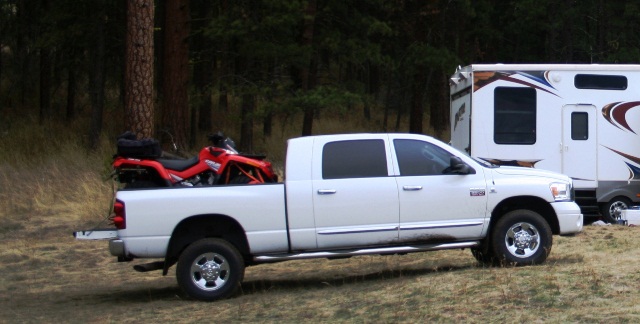
Here are some good ATV transport tips from offroad-ed.com.
Maintaining and Inspecting Trailering Equipment
* Confirm the trailer meets any state safety requirements.
* Check the tire pressure on the towing vehicle and the trailer. Make sure you have a spare tire in good condition for both the vehicle and the trailer. Also, make sure your car jack will work with your trailer, or get a jack that will.
* Tighten the lug nuts/bolts on the wheels of both the towing vehicle and the trailer, and grease the wheel bearings.
* Make sure that all lights and brakes on the towing vehicle and the trailer work properly.
* Examine tie-down straps, lines, safety chains, and hitch for signs of wear. Replace or adjust as necessary.
* Make sure your trailer is the correct type, size, and capacity for your ATV(s) and capacity for your ATV(s) and your towing vehicle.
Hitching the Trailer to the Towing Vehicle
When you hit a bump while driving down the road, the last thing you want is to look in the rear-view mirror and notice the trailer moving on its own. This happens, and it’s very dangerous. It’s critical that you hitch the trailer properly.
* Use a towing hitch of appropriate size and type for the loaded trailer.
* Make sure the size stamped on the ball hitch matches the size that is stamped on the trailer’s coupler. If the ball hitch is too small, a bump in the road could cause the coupler to lift off the hitch.
* Criss-cross two strong safety chains to support the trailer’s coupler if it becomes disconnected. The chains should be strong enough to hold the combined weight of the trailer and all vehicles on it.
* Connect the trailer to the towing vehicle’s lighting system. Make sure all the lights work, and don’t forget to check the brake lights and both blinkers.
Loading the ATV
When using a trailer, make sure it’s hitched securely to the towing vehicle. Otherwise, the trailer may tip backward and forward as you load the ATV.
* Wear your protective ATV gear—helmet, goggles, gloves, and boots.
* Use high-quality ramps with a rated load capacity that can withstand the combined weight of the ATV and its rider.
o Underrated ramps may buckle, causing the ATV to tip over or ram the back of the trailer or pickup.
o Hitting a ramp at high speed also can cause buckling.
* Attach the ramp securely to the trailer or pickup using straps or chains.
* Approach the ramp in first gear so you can climb it easily. Activate four-wheel drive low, if applicable.
Preparing the ATV for Transport
Minimize the risk of building up gasoline vapors, particularly when you transport the ATV in an enclosed trailer or other vehicle.
* Turn off the fuel valve. Run the engine until it stops, which empties the fuel line.
* If you’re transporting the ATV a long distance, drain the fuel tank.
* Leave the fuel valve and tank vent cap turned off to prevent gas vapors from leaking.
Securing the ATV
When using a trailer, position the ATV so its weight is centered slightly behind the axle. This position balances the trailer and decreases the weight on the trailer hitch.
* Set the parking brake.
* Use tie-down straps instead of ropes, which may stretch during transport.
* Use four straps whenever possible, front and back on both sides. Never use fewer than three straps.
* Cinch the straps as tightly as possible. Shake the ATV and make sure it’s secure. The tires should look like they’re carrying weight.
* Don’t let excess strap length drag below the trailer or pickup. Loop the excess, and tie it into a simple knot.
* When using a pickup, close the tailgate if possible.
* On long trips, pull over every hour or so to check the towing vehicle, trailer, tires, and trailer coupling.




